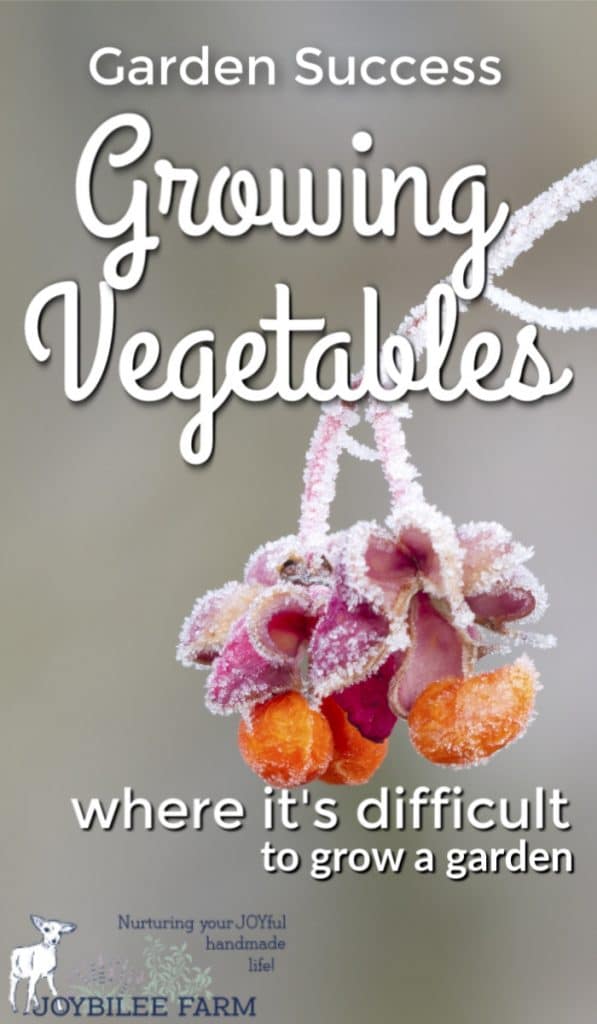For most places where folks can afford to homestead, growing food is difficult. Here are 10 tips that will help you with growing vegetables where it is difficult to grow your own food. Have a successful vegetable garden even in zone 3!
We live at 2,700 feet, in the southern interior of B.C., in the shadow of a ski hill. It’s cold. We can get frost any day of the year. Most of my neighbors don’t even try to grow food in these conditions. We grow about 80% of our vegetables and a bit of fruit, all of our own meat, eggs and milk (cheese, yogourt, ice cream, but not butter.) We haven’t tried to grow grain, but one of our neighbors grows wheat, rye, and oats, so it’s do-able here.
I learned my gardening skills on the coast in the balmy environment of zone 7b. The first summer here I was excited to grow more food. Grand Forks, just 20 minutes away, was Canada’s food security during WWII. So I had hope. I planted beans, corn, tomatoes, zucchini, pumpkins. Temperatures soared in July and the corn grew well. It got to tassel stage and I could taste the fresh corn, still growing on the stalks.
Then on July 30th, the unthinkable happened. I woke up to -3C in the garden. The corn, potatoes, well everything that I had been tending, was crispy and white with frost.
While the frost was still there, at 5 am, I raced down to the garden and turned on the sprinklers — a trick fruit farmers use to protect tender fruits in Spring. It worked. But the next morning there was frost again, and the next, and the next.
After a good cry, I gave up the fight and we revised our gardening plan.
Land Values Increase as the Climate is favorable to Gardening
If you are going to leave the rat race, quit your day job and find a little piece of paradise to grow your own food and be self-sufficient, you are going to buy land that’s difficult to farm or you are going to spend a lot of money. The more you spend on land, the bigger the mortgage, the longer it takes to pay it off. So you will get to your dreams sooner if you can find land a bit away from the ideal climate.
We’re in zone 3. Just 20 minutes West, Grand Forks is considered zone 5 and Christina Lake is zone 6. Unfortunately, land values increase as the climate gets more favorable to gardening.
We looked at land on Salt Spring–zone 8b. We could get 5 acres, with a house and guest house for about 25% more than we paid for our 140 acres with a log house. But that 25% more would have required a longer investment in citified labor, probably another 10 years that we were not ready to commit to, and we opted to go where the land was less expensive.
At the time we sold 1 acre with a 5 bedroom house in the city and gained 140 acres with a 3 bedroom house and had money left to get established.
We all know that land increases in value over time. There’s a limited amount of land, they aren’t making any more, so an investment in land increases in value in most years. If you own a townhouse, your increases in value are inflation based, the townhouse is actually depreciating as you own it. Same with a mobile home or apartment. But when there is land attached to your home, you are sitting pretty — the longer you hold it the more it’s worth.
Cities tend to build up around places where it’s easy to grow food, so most of the good farmland is close to the city. Farmer’s tend to have two jobs — one to support the family and another to support the farm. Don’t get sucked into this. You don’t need to.
Here are some steps you can use to increase your chances of a good harvest, where you live.
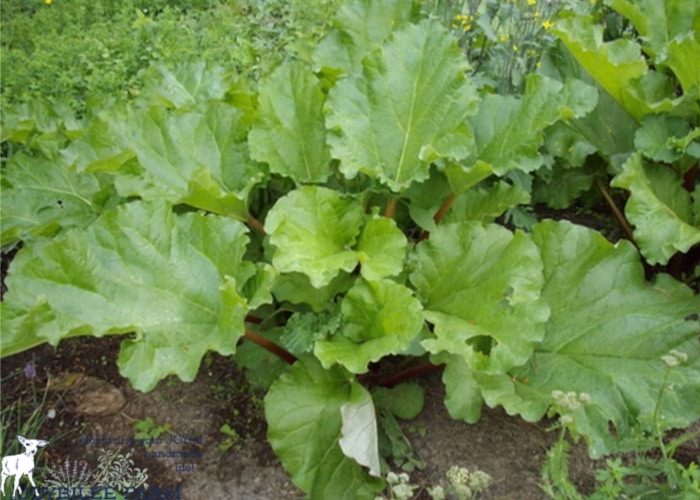
1. Create a frost drain
I was inspired by the Chinese miners that grew their own food around Barkerville. They terraced the hillsides around the town; Barkerville is in a narrow valley. Most mining towns, in fact, are near mountains. If you homestead in B.C. you will probably find land in a mining area. You can use the principles of terracing to increase your yields in a difficult climate. Terracing increases the available land you have to grow food in. It also drains frost away from tender plants, extending your season.
The principle is to place your plants a bit higher than the surrounding ground so that light frost will drain away. Raised beds can accomplish this or find a higher place on your property to put a garden. We have two gardens. A garden near the pastures that have level ground and gets lots of sun. This was my first garden. It gets frost rolling down the mountain from the ski hill, even on hot summer days. But it is the first place that thaws in the Spring and is ideal for my root vegetables and to start baby plants to transplant later, a bit higher up.
I have a second garden, near the house. It takes longer to thaw out in the Spring. It’s on the North side of the house. It’s so cold that my asparagus just started peeking up, while Grand Forks finished their asparagus about a month ago. That’s where I plant the broccoli, cabbage, cauliflower, bush beans and other crops that I raise under poly-cloth to keep it warmer. I haven’t had successful squash there, even covering it with a cloth.
2. Use polycloth or blankets to hold in heat
This year I’m trying to increase my chances of harvesting squash, by planting the squash in tires — to increase the heat, and covering them with poly-cloth to hold the heat in. In years past I started the squash in the house at the end of May and transplanted it out once it warms, into compost-filled tires. I’ve got them covered and the black of the tires will absorb more solar energy — hopefully giving it off at night to keep the plants growing well. Squash that only need 40-60 days are also best in my short season, so I can succeed in growing vegetables for my family.
3. Use a greenhouse to extend the season

Mr. Joybilee built a greenhouse that I can use as a holding place in the Spring for warm weather crops like tomato plants and squash. This extra protection makes a difference. He added an automatic window opener (Lee Valley Tools) to release heat when the greenhouse warms up. Its been so cold that it hasn’t needed to work much so far. We’re still waiting for summer to start. Every layer of cover for plants increases the temperature, so we also use protective fabric within the greenhouse to help even more with cold spring weather.

4. Plant what grows well in your climate
What grows well for me in zone 3? I’ve learned that there are many annuals that will produce within my short growing season. I have also continually added perennial vegetables to our farm over time. These perennials have become the backbone of our farm and we can count on them returning early in the spring, just as soon as the snow melts.
Annuals for zone 3:
- Anything from the Kole family: bok choy, Tsai choy, Chinese cabbages, broccoli, cauliflower, cabbage, turnips, and winter radish.
- Short-season cool weather crops like lettuce, chard, and spinach
- Root vegetables like potatoes, carrots, turnips, rutabagas, beets, onions and garlic
- With greenhouse protection, we can manage short-season beans, tomatoes, and squash, which require protection and warmth. I’ve learned that peppers and cucumbers need more heat than I can manipulate here.
Perennials for zone 3:
- Perennial greens have become a much anticipated early spring crop on the homestead. These wild weeds include lambs quarters, chickweed, volunteer orach, and many other self-seeding vegetables.
- We grow scallions, chives and Egyptian walking onions for a perpetual harvest in addition to our yearly bulbing onion crop.
- Jerusalem Artichoke is an easy to grow perennial also called sunchokes. They look pretty in the garden as well as providing food for your family. But beware, in some climates, they can take over an area, so plant them in an out of the way corner, not in the center of your flower bed. If you plant them right, you’ll be able to harvest them for many years, and they’ll be a great addition to your growing vegetables.
- We grow strawberries and asparagus in the same bed and have learned how to double our yields without chemicals. A well-managed perennial bed of asparagus and strawberries will continue to produce for 20 or even 30 years. The sooner you plant them in your garden, the sooner you’ll realize a harvest.
- Another crop that acts like a perennial in our garden and does extremely well for us is kale, which we can grow almost year-round. We begin harvesting the leaves for salads and snacks just 50 days after an early spring planting and the plants produce new leaves that will grow all summer as we continue to harvest. Kale lasts every year until snow cover.
- Fruit like rhubarb, huckleberries, strawberries, and saskatoons also do well on our farm.
- Short season apple trees have done well for us once we mastered fertilization techniques and the black walnut trees have started to produce fruit.
- Horseradish (Armoracia rusticana) is an easy to grow perennial herb that is hardy to zone 3. It is a vigorous grower that likes rich soil. It isn’t bothered by insect or fungal diseases. A large plant will spring from the smallest root.

5. Start longer season plants indoors and transplant out when it warms up
I plant the starter plants in paper cups and just tear the cups off when I’m ready to transplant. For plants like squash that don’t like to have their roots disturbed, this is a good solution. Its a balance between adequate light and warmth to get strong transplants. I don’t get strong light until May, so I usually start the squash then.
I have lots of friends in Grand Forks that start more tomato plants than they need and I’m happy to relieve their guilt and keep them from tossing perfectly good plants, by taking them off their hands. Its harder to grow tomato plants indoors, in low light conditions, without supplemental light. However, you can try growing even lettuce and tomatoes indoors if you want to succeed in growing vegetables all year round.
6. Keep the garden weeded
You will increase your harvest if you weed early in the season, just after the plants emerge and then take the time to keep it weeded or apply mulch to it. Properly spaced and weeded plants grow better and produce more food. I have more garden than one person can keep weeded. And I tend to get hopelessly behind on the weeding. We manage to get a harvest anyway when growing vegetables for our family. We also harvest weeds to eat too.
The harvest would be more abundant if I could manage to keep it weeded and mulch it early in the season. Every weed that goes to seed is 5 more years of weeding — so invest the time early in the season and it will pay dividends for years to come.
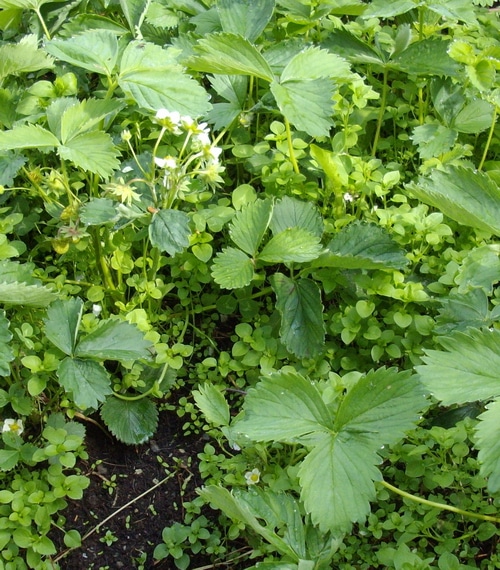
7. Thin out garden seedlings
Plants need to be properly spaced to grow to maximum size in the fastest possible time. This is essential in a short season environment. If plants are crowded in their beds, they grow slower, consume more water and nutrients, and generally don’t perform as well. You can get full-size carrots in the same amount of time and space, as tiny baby carrots, if you thin them early. You’ll get a larger harvest, by weight, too. You can transplant thinned plants to containers or new beds to grow more vegetables when you have a short growing vegetables season.
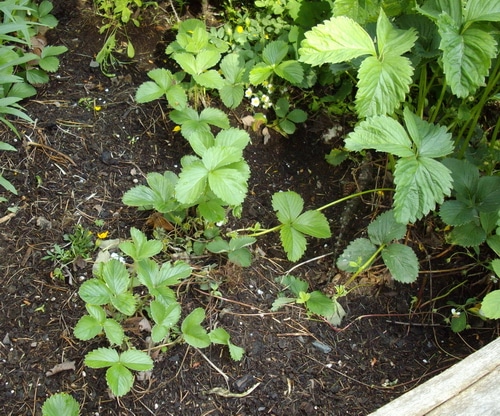
8. Barter for what you cannot grow
Tomatoes, peppers, cucumbers, and squash grow well in Grand Forks, just 30 km East of me, but I struggle to successfully grow them. The greenhouse has given me that chance to extend the season, but realistically, when you have 140 acres to tend, the limit on my time is to keep the weeds under control so I can keep growing vegetables that thrive for me.
We’ve decided that to add tomatoes, peppers, cucumbers, and squash to our diet, the best thing is to trade with some friends in Grand Forks. This works best for both of us. Our friends want my composted manure and I refuse to sell it to them. Instead, I trade them garden surplus for it. It’s a great arrangement since they’re gardens succeed in growing vegetables that I can’t.
My friends’ gardens over-produce because of the compost and I get blessed all season with the things I can’t grow. If there’s a crop failure the flow stops, but that’s ok, when you’re growing vegetables in your own garden, there’s always next year.
9. Buy in season and preserve it for the winter
I can a lot of tomatoes in season and we eat tomato sauce, salsa, and canned tomatoes all year, with just a few weeks of extra effort. Tomatoes grow really well in the Okanagan, just an hour away from me. So we plan a couple of trips each fall to stock up for the winter. We also purchase enough apples, cherries, peaches, and blueberries to round out what is currently growing on the farm. Eventually, we will not need to supplement, but by going to where these items grow in season, we can purchase at a good price and preserve them for the winter. I have an easy way to preserve cherry tomatoes.
For other food like grains, even grocery store food is less expensive when the new crops harvest comes in. Several years ago I bought 8 bags of 10 kg. flour in September for $5 per bag. The current price is $14 per bag (a profit of $9 per bag.) That’s a better investment than mutual funds.
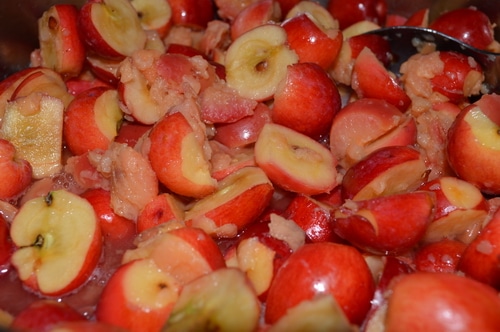
10. Be open to grace
Often, in an especially poor season, when my heart starts to worry about tomorrow, God will break through with gifts of food. One year a complete stranger drove in to look at my son’s old truck and harvest it for parts. He was an Okanagan grower and brought boxes of fruit. But even better, he invited us to come and pick his orchard. There were plums ripening on the trees with no one to take them. We picked over 10 boxes of plums, shared some, dried some for prunes, and froze the rest. Those plums provided enough for a couple of years.
When planning a garden for growing vegetables, don’t forget that many fruit trees, bushes, and plants are perennial and will give harvests for many years. Strawberries, hascaps, rhubarb, and other hardy fruits thrive for us, even if the tree fruits don’t.
Many seasons, our friend in Christina Lake (zone 6) has an abundance of apples and pears. We take boxes and help her pick her trees for a share of the harvest. Again, we eat fresh and dry for the winter, enough for a couple of years. Since apples tend to produce well in alternate years, this works out really well for us.
What tips can you share that help you extend your growing season or grow vegetables and fruit in a difficult climate? Do you have a food system for the kinds of food you can’t grow yourself? Leave a comment below, I’d love to see how things work in other parts of the world.


